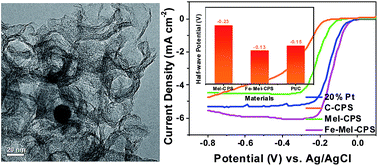Conversion of polystyrene foam to a high-performance doped carbon catalyst with ultrahigh surface area and hierarchical porous structures for oxygen reduction†
Abstract
A high-performance doped carbon catalyst with ultrahigh surface area (1123 m2 g−1) and hierarchical porous structures was prepared through an economical, non-template pyrolyzing approach using cross-linked polystyrene, melamine and iron chloride as precursors. The catalyst exhibits excellent oxygen reduction reaction (ORR) performance, outstanding methanol tolerance, remarkable stability, and high catalytic efficiency (nearly 100% selectivity for the four-electron ORR process). Remarkably, its ORR activity can even surpass that of the commercial Pt/C catalyst in alkaline media, with a half-wave potential 20 mV more positive. To the best of our knowledge, it is also one of the most active ORR catalysts in alkaline media to date. By investigating the effects of N dopants and Fe residue on the catalyst's ORR performance, we find that residual Fe is as important as doped nitrogen in enhancing the ORR performance. The catalyst's high ORR performance, outstanding stability and excellent methanol tolerance, combined with its hierarchical porous morphology, make it promising for the application in novel, environmentally friendly electrochemical energy systems. This research also provides a potential way to turn waste into wealth.

- This article is part of the themed collection: 2014 Journal of Materials Chemistry A Hot Articles

 Please wait while we load your content...
Please wait while we load your content...